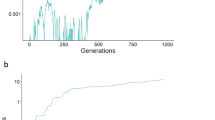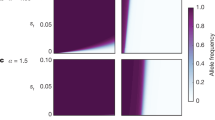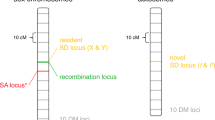Abstract
Sex is expensive. A population of females that reproduce asexually should prima facie have twice the growth rate of an otherwise equivalent anisogamous sexual population lacking paternal care, or a population with modes of paternal care that can be co-opted by parthenogenetic females1,2,3,4,5,6. The two leading theories for the maintenance of sex require either synergistic interactions between deleterious mutations, or antagonistic epistasis between beneficial mutations5. Current evidence is equivocal as to whether the required levels of epistasis exist6,7,8,9,10. Here I show that a third factor, differential male mating success (or, more generally, higher variance in male than in female fitness), can drastically reduce mutational load in sexual populations with or without any form of epistasis. Differential mating success has the further advantage of being ubiquitous, and is likely to have preceded or evolved concurrently with anisogamy11.
This is a preview of subscription content, access via your institution
Access options
Subscribe to this journal
Receive 51 print issues and online access
$199.00 per year
only $3.90 per issue
Buy this article
- Purchase on Springer Link
- Instant access to full article PDF
Prices may be subject to local taxes which are calculated during checkout

Similar content being viewed by others
References
Maynard Smith, J. in Group Selection (ed. Williams, G. C.) 163–175 (Aldine–Atherton, Chicago, 1971).
Kondrashov, A. Deleterious mutations and the evolution of sexual reproduction. Nature 336, 435–440 (1988).
Kondrashov, A. Classification of hypotheses on the advantages of amphimixis. J. Hered. 84, 372–387 (1993).
Hurst, L. D. & Peck, J. R. Recent advances in understanding of the evolution and maintenance of sex. Trends Evol. Ecol. 11, 46–52 (1996).
Barton, N. H. & Charlesworth, B. Why sex and recombination? Science 281, 1986–1989 (1998).
West, S. A., Lively, C. M. & Read, A. F. A pluralist approach to sex and recombination. J. Evol. Biol. 12, 1003–1012 (1999).
Lenski, R. E., Ofria, C., Collier, T. C. & Adami, C. Genome complexity, robustness and genetic interactions in digital organisms. Nature 400, 661–664 (1999).
Elena, S. F. & Lenski, R. E. Test of synergistic interactions among deleterious mutations in bacteria. Nature 390, 395–398 (1997).
De Visser, J. A. G. M. & Hoekstra, R. F. Synergistic epistasis between loci affecting fitness: evidence in plants and fungi. Genet. Res. Camb. 71, 39–49 (1998).
West, S. A., Peters, A. D. & Barton, N. H. Testing for epistasis between deleterious mutations. Genetics 149, 435–444 (1998).
Bell, G. The Masterpiece of Nature: The Evolution and Genetics of Sexuality (Univ. California Press, Berkeley, 1982).
Trivers, R. L. Sexual selection and resource-accruing abilities in Anolis garmani. Evolution 30, 253–269 (1976).
Atmar, W. On the role of males. Anim. Behav. 41, 195–205 (1991).
Koeslag, P. D. & Koeslag, J. H. Koinophilia stabilizes bi-gender sexual reproduction against asexual in an unchanging environment. J. Theor. Biol. 166, 251–260 (1994).
Kodric-Brown, A. & Brown, J. H. Anisogamy, sexual selection, and the evolution and maintenance of sex. Evol. Ecol. 1, 95–105 (1987).
Manning, J. T. Males and the advantage of sex. J. Theor. Biol. 108, 215–220 (1984).
Kondrashov, A. S. & Crow, J. F. King's formula for the mutation load with epistasis. Genetics 120, 853–856 (1988).
Fisher, R. A. The Genetical Theory of Natural Selection (Clarendon Press, Oxford, 1930).
Rohlf, F. J. & Sokal, R. R. Statistical Tables (W. H. Freeman, New York, 1994).
Simmons, M. J. & Crow, J. F. Mutations affecting fitness in Drosophila populations. Ann. Rev. Genet. 11, 49–78 (1977).
Petrie, M., Halliday, T. & Sanders, C. Peahens prefer peacocks with elaborate trains. Anim. Behav. 41, 323–332 (1991).
Dale, S., Rinde, H. & Slagsvold, T. Competition for a mate restricts mate search of female pied flycatchers. Behav. Ecol. Sociobiol. 30, 165–176 (1992).
Holland, B. & Rice, W. R. Experimental removal of sexual selection reverses intersexual antagonistic coevolution and removes a reproductive load. Proc. Natl Acad. Sci. USA 96, 5083–5088 (1999).
Lynch, M. et al. Perspective: spontaneous deleterious mutation. Evolution 63, 645–663 (1999).
Keightley, P. D. & Eyre-Walker, A. Terumi Mukai and the riddle of deleterious mutation rates. Genetics 153, 515–523 (1999).
Keightley, P. D. & Eyre-Walker, A. Deleterious mutations and the evolution of sex. Science 290, 331–333 (2000).
Kondrashov, A. S. Sex and U. Trends Genet. 17, 75–77 (2000).
Arnold, S. J. et al. Sexual selection in plants and animals. Am. Nat. 144, S1–S149 (1994).
Acknowledgements
I would like to thank R. Dawkins, L. Eshel, A. Grafen, L. Hurst, A. Kacelnik, A. Kondrashov, J. Metcalf, R. Nair, S. Schultz, F. Weissing, and in particular, M. Ridley for their comments on drafts of this manuscript.
Author information
Authors and Affiliations
Rights and permissions
About this article
Cite this article
Siller, S. Sexual selection and the maintenance of sex. Nature 411, 689–692 (2001). https://doi.org/10.1038/35079578
Received:
Accepted:
Published:
Issue Date:
DOI: https://doi.org/10.1038/35079578
This article is cited by
-
Sexual selection for males with beneficial mutations
Scientific Reports (2022)
-
Genomic evidence that a sexually selected trait captures genome-wide variation and facilitates the purging of genetic load
Nature Ecology & Evolution (2022)
-
Multivariate selection and the making and breaking of mutational pleiotropy
Evolutionary Ecology (2022)
-
Meta-analytic evidence that sexual selection improves population fitness
Nature Communications (2019)
-
Male-benefit sexually antagonistic genotypes show elevated vulnerability to inbreeding
BMC Evolutionary Biology (2017)
Comments
By submitting a comment you agree to abide by our Terms and Community Guidelines. If you find something abusive or that does not comply with our terms or guidelines please flag it as inappropriate.



